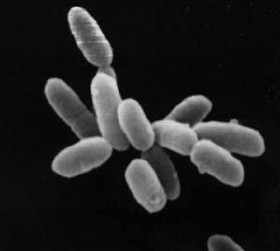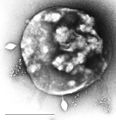Archaea facts for kids
Quick facts for kids Archaea (Archaebacteria) |
|
|---|---|
 |
|
| Halobacterium sp. strain NRC-1, each cell about 5 μm long |
|
| Scientific classification |
|
| Domain: | Archaea Woese, Kandler & Wheelis, 1990 |
| Kingdoms and phyla | |
|
|
| Synonyms | |
|
|
The Archaea (or Archea) are a group of single-celled organisms. The name comes from Greek αρχαία, "old ones". They are a major division of living organisms.
Archaea are tiny, simple organisms. They were originally discovered in extreme environments (extremophiles), but are now thought to be common to more average conditions. Many can survive at very high (over 80 °C) or very low temperatures, or highly salty, acidic or alkaline water. Some have been found in geysers, black smokers, oil wells, and hot vents in the deep ocean. Recent research has found ammonia-eating archaea in soil and seawater.
In the past they had been classed with bacteria as prokaryotes (or Kingdom Monera) and named archaebacteria, but this is a mistake. The Archaea have an independent evolutionary history and show many differences in their biochemistry from other forms of life. They are now classified as a separate domain in the three-domain system. In this system, the three distinct branches of evolutionary descent are the Archaea, Bacteria and Eukaryota.
Archaea are, like bacteria, prokaryotes: single-celled organisms that do not have nuclei and cell organelles of the eukaryote type.
Comparison to other domains
The following table compares some major characteristics of the three domains, to illustrate their similarities and differences. Many of these characteristics are also discussed below.
| Property | Archaea | Bacteria | Eukarya |
|---|---|---|---|
| Cell membrane | Ether-linked lipids, pseudopeptidoglycan | Ester-linked lipids, peptidoglycan | Ester-linked lipids, various structures |
| Gene structure | Circular chromosomes, similar translation and transcription to Eukarya | Circular chromosomes, unique translation and transcription | Multiple, linear chromosomes, similar translation and transcription to Archaea |
| Internal cell structure | No membrane-bound organelles (but questioned:) or nucleus | No membrane-bound organelles or nucleus | Membrane-bound organelles and nucleus |
| Metabolism | Various, with methanogenesis unique to Archaea | Various, including photosynthesis, aerobic and anaerobic respiration, fermentation, and autotrophy | Photosynthesis, cellular respiration and fermentation |
| Reproduction | Asexual reproduction, horizontal gene transfer | Asexual reproduction, horizontal gene transfer | Sexual and asexual reproduction |
= Interesting facts about archaea:
- No archaean species can do photosynthesis.
- Archaea only reproduce asexually.
- Archaea show high levels of horizontal gene transfer between lineages.
- Many archaea live in extreme environments.
- Unlike bacteria, no archaea produce spores.
- Archaea are common in the ocean, and especially in the plankton. They make up to 20% of all microbial cells in the ocean.p475
- Carl Woese discovered the Archaea in 1978.
Related pages
- Barry E.R. & Bell S.D. 2006. DNA replication in the Archaea. Microbiology and molecular biology reviews (MMBR) '70, 876-887.
- Kelman L.M. & Kelman Z. 2003. Archaea: An archetype for replication initiation studies? Molecular microbiology, 48, 605-615.
- Archaea -Citizendium
Images for kids
-
Archaea were found in volcanic hot springs. Pictured here is Grand Prismatic Spring of Yellowstone National Park.
-
Bacteriorhodopsin from Halobacterium salinarum. The retinol cofactor and residues involved in proton transfer are shown as ball-and-stick models.
-
Sulfolobus infected with the DNA virus STSV1. Bar is 1 micrometer.
-
Archaea that grow in the hot water of the Morning Glory Hot Spring in Yellowstone National Park produce a bright colour
See also
 In Spanish: Archaea para niños
In Spanish: Archaea para niños








